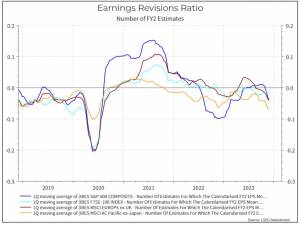Growth and inflation have, as usual, been the focus of attention this week. In the US, we saw some revisions to third-quarter GDP figures, which revised higher – suggesting that the economy expanded by 5.2% quarter-on-quarter – a remarkably strong figure. At the same time, a measure of inflation (Core PCE prices) was revised downwards slightly from the initial estimate. Accelerating growth and decelerating inflation is a happy combination!
The picture in Europe wasn’t quite so rosy. French GDP declined 0.1% quarter on quarter in the three months ending September, below expectations. Happily, preliminary inflation estimates for November also came in lower than expected at 3.8% year-on-year. That was consistent with wider Eurozone data that showed inflation decelerating faster than expected last month.
As we’ve said before, while there are still risks, we think that inflation will continue to decelerate towards the 2% target of the Fed/ECB/Bank of England. The immediate question is really around growth. Will the US economy really be able to achieve a “no-landing” scenario – ie having inflation converge towards the target without a significant slowdown in growth? The evidence so far looks pretty good, based on this week’s data.
But there are some signs of a slowdown. The Federal Reserves Beige Book – a summary of feedback from across the US – is released eight times per year. The most recent release, from this week, highlighted weaker demand across many parts of the country. Recent comments from Fed governors suggest that some of them are taking this feedback seriously. Another data point to consider is the continuing unemployment claims figure, which is drifting gradually higher over time. That partly explains why a December rate hike is probably off the table. It will be interesting to see if this anecdotal evidence begins to get reflected in hard data in the coming months.
It’s an important question for several reasons, but not least because many investors are banking on the Federal Reserve cutting rates around mid-2024. But if you think the economy is still growing above ‘potential’ growth, why would you act quickly to lower policy rates? If the US economy stays strong, investors hoping for an early rate cut in the US may be disappointed.
In Europe and the UK, the picture on growth is already more challenging. We may not quite be in a technical recession – but if the economy is stagnant, do we really care if the statistics say it’s at zero or slightly contracting? The challenge for Central Bankers here, we’d argue, is slightly different. Inflation isn’t yet back at target, while the economy is weak, but not so weak as to make cutting rates an obvious decision yet.
Slower than expected growth weighing on equities?
From an equity perspective, we care about the relationship between economic activity and corporate earnings. Some data suggests that the slower growth may be having an impact. The chart below shows earnings revisions over time – ie how analysts’ expectations about company earnings have changed. We can see a deterioration over the past few months. If we see slower growth over the coming quarters, those metrics could weaken further.

 Richard Flax: Richard is the Chief Investment Officer at Moneyfarm. He joined the company in 2016. He is responsible for all aspects of portfolio management and portfolio construction. Prior to joining Moneyfarm, Richard worked in London as an equity analyst and portfolio manager at PIMCO and Goldman Sachs Asset Management, and as a fixed income analyst at Fleming Asset Management. Richard began his career in finance in the mid-1990s in the global economics team at Morgan Stanley in New York. He has a BA from Cambridge University in History, an MA from Johns Hopkins University in International Relations and Economics, and an MBA from Columbia University Graduate School of Business. He is a CFA charterholder.
Richard Flax: Richard is the Chief Investment Officer at Moneyfarm. He joined the company in 2016. He is responsible for all aspects of portfolio management and portfolio construction. Prior to joining Moneyfarm, Richard worked in London as an equity analyst and portfolio manager at PIMCO and Goldman Sachs Asset Management, and as a fixed income analyst at Fleming Asset Management. Richard began his career in finance in the mid-1990s in the global economics team at Morgan Stanley in New York. He has a BA from Cambridge University in History, an MA from Johns Hopkins University in International Relations and Economics, and an MBA from Columbia University Graduate School of Business. He is a CFA charterholder.
*As with all investing, financial instruments involve inherent risks, including loss of capital, market fluctuations and liquidity risk. Past performance is no guarantee of future results. It is important to consider your risk tolerance and investment objectives before proceeding.





